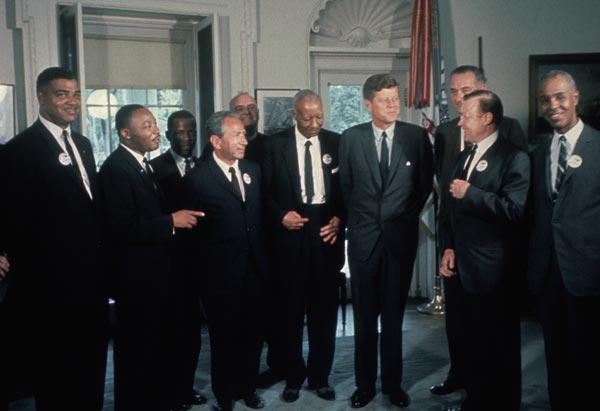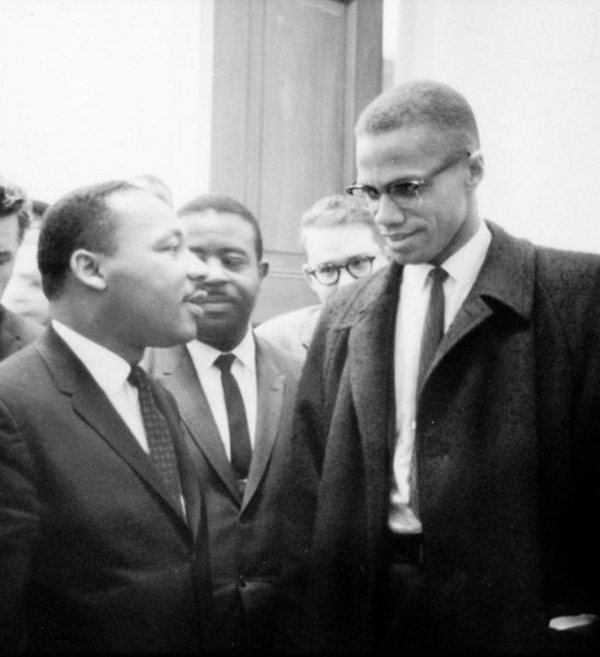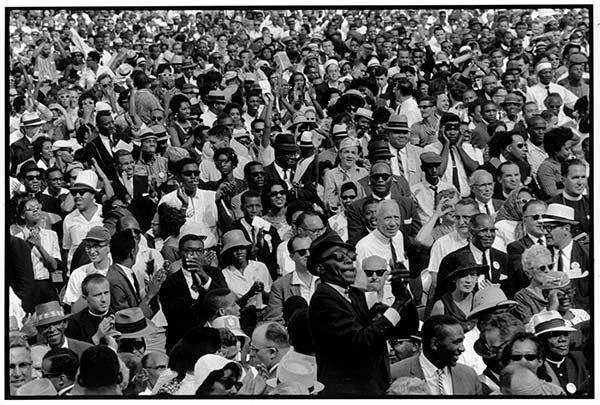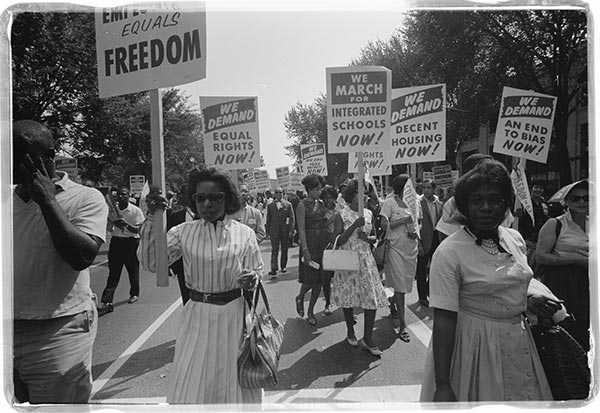SECTION 06
The March on Washington and the Civil Rights Act
Civil rights leaders meet with President Kennedy and Vice President Johnson.
Source: Records of the NAACP, Library of Congress.
President John F. Kennedy was not unmoved by the carnage of Birmingham, but the racial crisis alone would not have prompted his next actions. Many corporate leaders had come to the conclusion that desegregation was inevitable and that it was in the best interest of big business to support civil rights to ensure the continuation of business expansion. On June 12, 1963, Kennedy announced that he would deliver to Congress a strong civil rights bill. Later, promoting its passage, the president defended it "not merely for reasons of economic efficiency, world diplomacy, and domestic tranquility, but above all because it is right." Yet, it is important to understand Kennedy's motivations for embracing desegregation. Kennedy personally felt no great discomfort with racial segregation and, in fact, had been supported by many Southern congressmen as a racial moderate. However, as the Cold War accelerated in the 1960s--communist forces were winning in Laos and Vietnam; Castro was in power in Havana; a bloody civil war raged in the Congo-- Kennedy and his advisers had to view the struggle for civil rights in a global context: the image of battered and bloody children lying in the streets of the American South undermined any positive image the United States was trying to create among the world's nonaligned countries.
Martin Luther King, Jr. and Malcolm X meet during a Senate Debate on the Civil Rights Act of 1964.
Source: Marion S. Trikosko, March 1964, Library of Congress Prints and Photographs Division, Washington, DC.
As Kennedy announced the civil rights bill to Congress in the nation's capital, a major protest was being planned for its front lawn. Civil rights leaders began to discuss among themselves the idea of reviving A. Philip Randolph's 1941 March on Washington movement. Activists in SNCC and CORE insisted that the march become a mass act of civil disobedience, paralyzing the nation's capital. But white liberals, along with members of the NAACP, Urban League, and the Southern Christian Leadership Conference (SCLC) insisted that the march should be planned in complete cooperation with federal authorities. Certainly the march would not have been approved without the moderate tone of its preparation. Instead of an angry demonstration of students and workers, the March on Washington for Jobs and Freedom became a festive celebration used to support Kennedy's civil rights bill. The result was a biracial audience of more than 250,000 standing in front of the Lincoln Memorial on August 23, 1963.
African American protest for equal rights, 1963.
Source: Warren K. Leffler, Library of Congress Prints and Photographs Division.
The day served as a highlight for many people who had traveled from every area of the nation to hear the impressive list of civil rights leaders. The speeches were, for the most part, in support of the Kennedy bill and promoting integration and equal rights. SNCC leader John Lewis's eloquent polemic on United States racism was revised just before he was to go on stage as it was marked as too radical for the moderate tone of the day. The highlight proved to be the impromptu end of Dr. Martin Luther King's speech, an oratory vision of a different kind of world that imagined the real potential of American democracy. Yet although a joyous day, the march itself did little to cement the support of the federal government for the desegregation of the South. Not a single vote in Congress changed after August 1963.
Related Resources
At the nation's capital, 1963.
On August 28, 1963, thousands of activists, community leaders and citizens convened on the nation's capital to hear the words of some of the most prominent civil rights leaders.
Source: Bruce Davidson/Magnum Photos.
Martin Luther King, Jr. and Malcolm X meet during a Senate Debate on the Civil Rights Act of 1964.
Source: Marion S. Trikosko, March 1964, Library of Congress Prints and Photographs Division, Washington, DC.
African American protest for equal rights, 1963.
A procession of African Americans carrying signs for equal rights, integrated schools, decent housing, and an end to bias, August 28, 1963.
Source: Warren K. Leffler, Library of Congress Prints and Photographs Division.
Civil rights leaders meet with President Kennedy and Vice President Johnson.
Civil rights leaders, including Martin Luther King, Jr., A. Philip Randolph, Roy Wilkins, and John Lewis meet with President Kennedy and Vice President Johnson to discuss Civil Rights, August 28, 1963.
Source: Records of the NAACP, Library of Congress.





